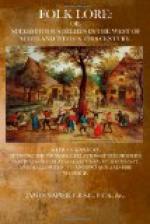There was quite a host of curious superstitions connected with this midsummer feast, especially in Ireland and Germany, and many of these were similar to those connected with the feast of Hallowe’en in Scotland. In Ireland, in olden times, it was believed that the souls of people left their sleeping bodies, and visited the place where death would ultimately overtake them; and there were many who, in consequence, would not sleep, but sat up all night. People also went out on St. John’s eve to gather certain plants which were held as sacred, such as the rose, the trifoil, St. John’s wort, and vervain, the possession of which gave them influence over evil. To catch the seed of the fern as it fell to the ground on St. John’s eve, exactly at twelve o’clock, was believed to confer upon the persons who caught it the power of rendering themselves invisible at will.
In my opinion, the great prehistoric midsummer festival to the sun god has diverged into the two Church feasts, Eucharist and St. John’s day; but St. John’s day has absorbed the greater share of old customs and superstitious ideas, and so numerous are they that the most meagre description of them would yield matter for an hour’s reading.
HALLOWE’EN.
The northern nations, like the Hebrews, began their day in the evening. Thus we have Yule Eve, and Hallow Eve (Hallowe’en), the evenings preceding the respective feasts. The name Hallowe’en is of Christian origin, but the origin of the feast itself is hidden in ancient mythology. The Celtic name for the autumn festival was Sham-in, meaning Baal’s Fire. The Irish Celts called it Sainhain, or Sainfuin; Sain, summer, and Fuin, end,—i.e., the end of summer. The Hebrews and Phoenicians called this festival Baal-Shewin, a name signifying the principle of order. The feast day in Britain and Ireland is the first of November. The Druids are said on this day to have sacrificed horses to the sun, as a thank-offering for the harvest. An Irish king, who reigned 400 A.D., commanded sacrifices to be made to a moon idol, which was worshipped by the people on the evening of Sain-hain. Sacrifices were also offered on this night to the spirits of the dead, who were believed to have liberty at this season to visit their old earthly haunts and their friends,—a belief this, which was entertained by many ancient nations, and was the origin of many of the curious superstitious customs still extant in this country on Hallowe’en. Dr. Smith, commenting in Jamieson’s Dictionary on the solemnities of Beltane, says, “The other of these solemnities was held upon Hallow Eve, which in Gaelic still retains the name of Sham-in,—this word signifying the Fire of Peace, or the time of kindling the fire for maintaining peace. It was at this season that the Druids usually met in the most central places of every country to adjust every




